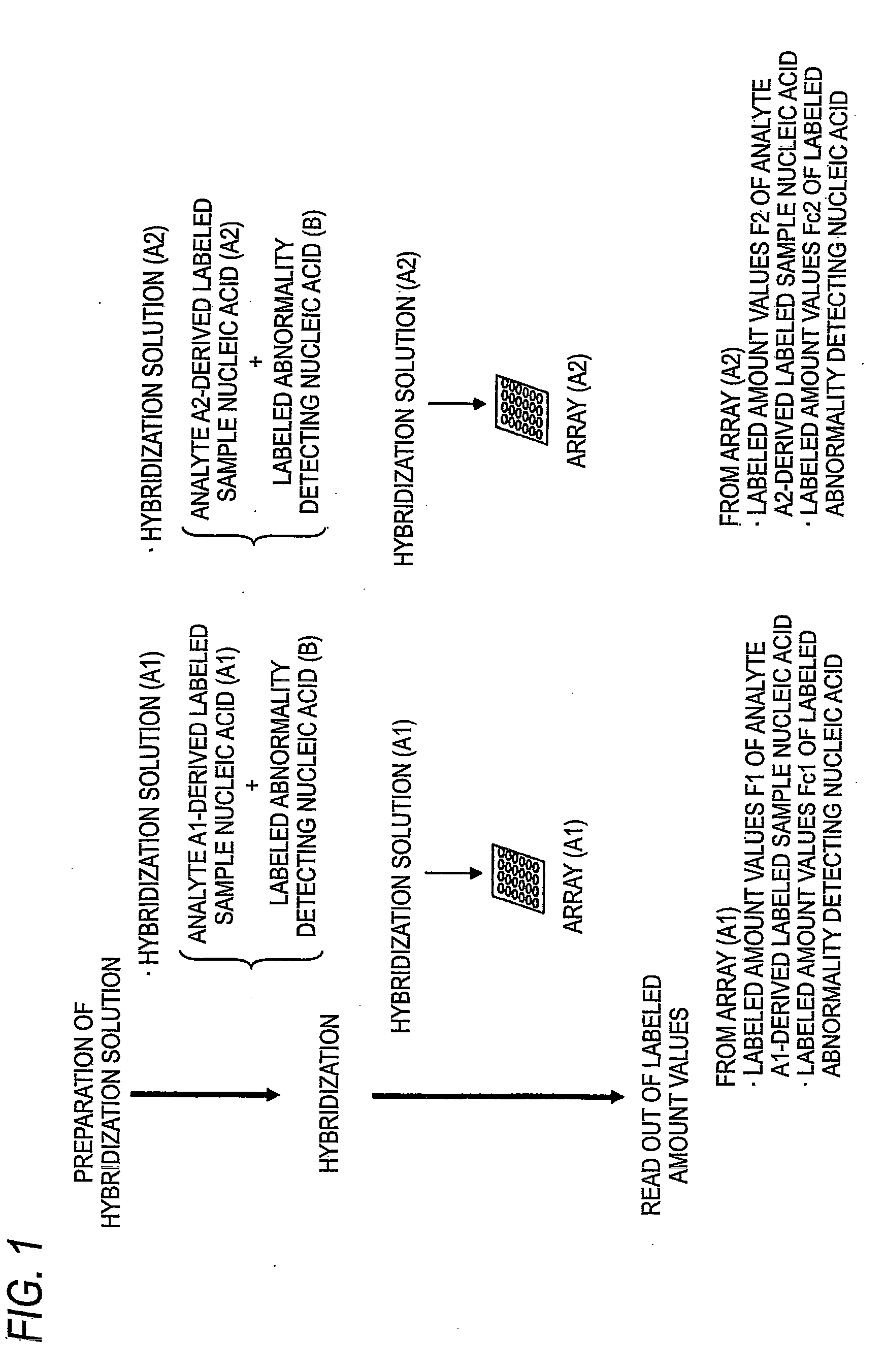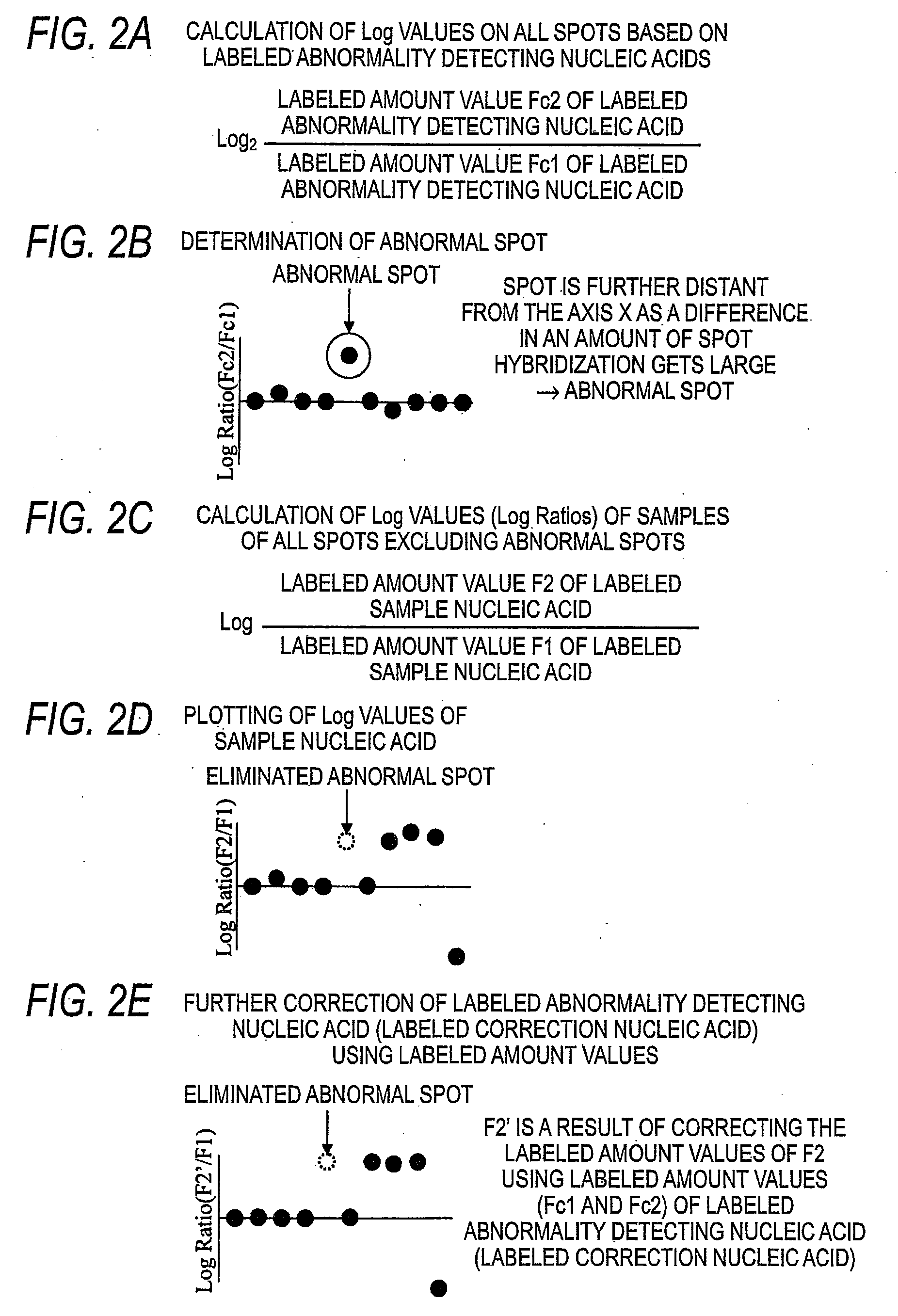Method for detecting abnormal spots of nucleic acid microarray
a nucleic acid microarray and abnormal spot technology, applied in the field of abnormal spot detection, can solve the problems of inability to detect chromosomal aberration, spot variation, and detection resolution, so as to reduce the variation of data among nucleic acid microarrays, accurate data, and reduced error in target nucleic acid labeled quantity valu
- Summary
- Abstract
- Description
- Claims
- Application Information
AI Technical Summary
Benefits of technology
Problems solved by technology
Method used
Image
Examples
example 1
Results of Analysis of Nucleic Acid Microarray in the Case of Eliminating Abnormal Spots
[0231]On the results of Comparative Example 1, abnormal spots were detected through numerical calculation by the following method.
[0232]By regarding the Cy5-Cot-1 DNA-derived fluorescence value obtained from the Cy3-Female-hybridized nucleic acid microarray as Fc1, and the Cy5-Cot-1 DNA-derived fluorescence value obtained from the Cy3-Male-hybridized nucleic acid microarray as Fc2, their Log Ratio {Log Ratio(Cot-1 / Cot-1)} was calculated as comparative value (DB) by the following formula.
Log Ratio(Cot-1 / Cot-1)=Log2(Fc2 / Fc1)
[0233]In this connection, the comparative value (DB) was calculated between spots having the same Block Number, the same Column Number and the same Row Number of the Cy3-Female-hybridized nucleic acid microarray and the y3-Male-hybridized nucleic acid microarray, and the comparative value (DB) was calculated on all of the spots spotted on the nucleic acid microarrays.
[0234]Next,...
example 2
Quality Inspection of Nucleic Acid Microarray Using Labeled Abnormality Detecting Nucleic Acid
[0253]In this inventive example, it is assumed that a nucleic acid microarray 1 is possessed by the manufacturer and nucleic acid microarrays 2 and 3 are possessed by the user.
[0254]Cy3-Female DNA and Cy5-Male DNA were prepared by the same method of the of Comparative Example 1.
[0255]Cy5-Cot-1 DNA was prepared by the same method of the of Comparative Example 1. In this connection, all of the labeled abnormality detecting (correcting) nucleic acid Cy5-Cot-1 DNA samples to be hybridized with the nucleic acid microarrays 1 to 3 were used by subdividing from the same preparation batch.
[0256]This was prepared by the same method of the of Comparative Example 1.
[0257]This was prepared by the same method of the of Comparative Example 1. However, the hybridization solution containing labeled abnormality detecting (correcting) nucleic acid was prepared by adding and mixing, instead of the unpurif...
example 3
In the Case of Keeping at Least One Spot when all Spots of the Spots Spotted with the Same Probe were Determined as Abnormal Spots
[0275]Cy3-Sample A and Cy3-Sample B were prepared by the same method of the of Comparative Example 1. The sample A is DNA which was obtained from a cell which was obtained by immortalizing and cultivating patient specimen who is female and has defect in the chromosome 7. The sample B is DNA which was obtained from blood of a person who is female and has no genetic mutation.
[0276]Cy5-Cot-1 DNA was prepared by the same method of the of Comparative Example 1. In this connection, all of the labeled abnormality detecting (correcting) nucleic acid Cy5-Cot-1 DNA samples to be hybridized with the nucleic acid microarrays 1 and 2 were used by subdividing from the same preparation batch.
[0277]This was prepared by the same method of the of Comparative Example 1.
[0278]This was prepared by the same method of the of Comparative Example 1.
[0279]Pretreatment was carr...
PUM
| Property | Measurement | Unit |
|---|---|---|
| temperature | aaaaa | aaaaa |
| temperature | aaaaa | aaaaa |
| time | aaaaa | aaaaa |
Abstract
Description
Claims
Application Information
 Login to View More
Login to View More - R&D
- Intellectual Property
- Life Sciences
- Materials
- Tech Scout
- Unparalleled Data Quality
- Higher Quality Content
- 60% Fewer Hallucinations
Browse by: Latest US Patents, China's latest patents, Technical Efficacy Thesaurus, Application Domain, Technology Topic, Popular Technical Reports.
© 2025 PatSnap. All rights reserved.Legal|Privacy policy|Modern Slavery Act Transparency Statement|Sitemap|About US| Contact US: help@patsnap.com



